Coefficient field inversion in an elliptic partial differential equation
We consider the estimation of a coefficient in an elliptic partial differential equation as a model problem. Depending on the interpretation of the unknowns and the type of measurements, this model problem arises, for instance, in electrical impedence tomography.
Let \(\Omega\subset\mathbb{R}^n\), \(n\in\{1,2,3\}\) be an open, bounded domain and consider the following problem:
\[\min_{m} J(m):=\frac{1}{2}\int_\Omega (u-d)^2\, dx + \frac{\gamma}{2}\int_\Omega |\nabla m|^2\,dx,\]where \(u\) is the solution of
\[\begin{split} \quad -\nabla\cdot(e^m\nabla u) &= f \text{ in }\Omega,\\ e^m \nabla u &= j \text{ on }\partial\Omega. \end{split}\]| Here \(m\in \mathcal{M}:=\{m\in H^1(\Omega) \bigcap L^{\infty}(\Omega)\}\) denotes the unknown coefficient field, $$u \in \mathcal{V}:= \left{v \in H^1(\Omega) | v(\boldsymbol{x}_c) = 0 \text{ for a given point } \boldsymbol{x}_c\in \Omega \right}\(the state variable,\)d\(the (possibly noisy) data,\)j\in H^{-1/2}(\partial\Omega)\(a given boundary force, and\)\gamma\ge 0$$ the regularization parameter. |
The variational (or weak) form of the state equation:
Find \(u\in \mathcal{V}\) such that
\[\int_{\Omega}e^m \nabla u \cdot \nabla \tilde{p} \, dx - \int_{\partial \Omega} j \tilde{p} \,dx = 0, \text{ for all } \tilde{p} \in \mathcal{V}.\]Gradient evaluation:
The Lagrangian functional \(\mathscr{L}: \mathcal{V} \times \mathcal{M} \times \mathcal{V} \rightarrow \mathbb{R}\) is given by
\[\mathscr{L}(u,m,p):= \frac{1}{2}\int_{\Omega}(u-u_d)^2 dx + \frac{\gamma}{2}\int_\Omega \nabla m \cdot \nabla m dx + \int_{\Omega} e^m\nabla u \cdot \nabla p dx - \int_{\partial \Omega} j\,p\, dx.\]Then the gradient of the cost functional \(\mathcal{J}(m)\) with respect to the parameter \(m\) is
\[(\mathcal{G}(m), \tilde m) := (\mathscr{L}_m(u,m,p),\tilde{m}) = \gamma \int_\Omega \nabla m \cdot \nabla \tilde{m}\, dx + \int_\Omega \tilde{m}e^m\nabla u \cdot \nabla p\, dx \quad \forall \tilde{m} \in \mathcal{M},\]where \(u \in \mathcal{V}\) is the solution of the forward problem,
\[(\mathscr{L}_p(u,m,p), \tilde{p}) := \int_{\Omega}e^m\nabla u \cdot \nabla \tilde{p}\, dx - \int_{\partial\Omega} j\,\tilde{p}\, dx = 0 \quad \forall \tilde{p} \in \mathcal{V},\]and \(p \in \mathcal{V}\) is the solution of the adjoint problem,
\[(\mathscr{L}_u(u,m,p), \tilde{u}) := \int_{\Omega} e^m\nabla p \cdot \nabla \tilde{u}\, dx + \int_{\Omega} (u-d)\tilde{u}\,dx = 0 \quad \forall \tilde{u} \in \mathcal{V}.\]Hessian action:
To evaluate the action \(\mathcal{H}(m)(\hat{m})\) of the Hessian is a given direction \(\hat{m}\) , we consider variations of the meta-Lagrangian functional
\[\begin{aligned} \mathscr{L}^H(u,m,p; \hat{u}, \hat{m}, \hat{p}) := & {} & {} \\ {} & \gamma\int_\Omega \nabla m\cdot \nabla \hat{m}\, dx + \int_\Omega\hat{m}e^m\nabla u \cdot \nabla p\, dx & \text{gradient}\\ {} & + \int_\Omega e^m\nabla u \cdot \nabla \hat{p}\,dx - \int_{\partial\Omega} j\, \hat{p}\, dx & \text{forward eq}\\ {} & + \int_\Omega e^m\nabla p \cdot \nabla \hat{u}\,dx + \int_\Omega (u-u_d)\,\hat{u}\, dx & \text{adjoint eq}. \end{aligned}\]Then action of the Hessian is a given direction \(\hat{m}\) is
\[\begin{aligned} (\tilde{m}, \mathcal{H}(m)(\hat{m}) ) & := \left(\mathscr{L}^H_m(u,m,p; \hat{u}, \hat{m}, \hat{p}), \tilde{m}\right) \\ {} & = \int_\Omega \tilde{m} e^m \nabla \hat{u} \cdot \nabla{p}\, dx + \gamma \int_\Omega \nabla \hat{m} \cdot \nabla \tilde{m}\,dx + \int_\Omega \tilde{m} \hat{m} e^m \nabla u\cdot \nabla p\,dx + \int_\Omega \tilde{m} e^m \nabla u\cdot \nabla \hat{p}\, dx \quad \forall \tilde{m} \in \mathcal{M}, \end{aligned}\]where
-
\(u\in \mathcal{V}\) and \(p \in \mathcal{V}\) are the solution of the forward and adjoint problem, respectively;
-
\(\hat{u} \in \mathcal{V}\) is the solution of the incremental forward problem,
- and \(\hat{p} \in \mathcal{V}\) is the solution of the incremental adjoint problem, \(\left( \mathscr{L}^H_u(u,m,p; \hat{u}, \hat{m}, \hat{p}), \tilde{u}\right) := \int_\Omega \hat{u} \tilde{u}\,dx + \int_\Omega \hat{m} e^m\nabla p \cdot \nabla \tilde{u}\,dx + \int_\Omega e^m \nabla \tilde u \cdot \nabla \hat{p}\,dx = 0 \quad \forall \tilde{u} \in \mathcal{V}.\)
Inexact Newton-CG:
Written in abstract form, the Newton Method computes an update direction \(\hat{m}_k\) by solving the linear system
\[\left(\tilde{m}, \mathcal{H}(m_k)(\hat{m}_k) \right) = -\left(\tilde{m}, \mathcal{G}(m_k)\right) \quad \forall \tilde{m} \in \mathcal{M},\]where the evaluation of the gradient \(\mathcal{G}(m_k)\) involve the solution \(u_k\) and \(p_k\) of the forward and adjoint problem (respectively) for \(m = m_k\). Similarly, the Hessian action \(\mathcal{H}(m_k)(\hat{m}_k)\) requires to additional solve the incremental forward and adjoint problems.
Discrete Newton system:
\(\def\tu{\tilde u} \def\tm{\tilde m} \def\tp{\tilde p} \def\hu{\hat u} \def\hp{\hat p} \def\hm{\hat m}\) \(\def\bu \def\bm \def\bp \def\btu \def\btm \def\btp \def\bhu \def\bhm \def\bhp \def\bg\) \(\def\bA \def\bC \def\bH \def\bR \def\bW\)
Let us denote the vectors corresponding to the discretization of the functions \(u_k, m_k, p_k\) by \(\bu_k, \bm_k, \bp_k\) and of the functions \(\hu_k, \hm_k, \hp_k\) by \(\bhu_k, \bhm_k,\bhp_k\).
Then, the discretization of the above system is given by the following symmetric linear system:
\[\bH_k \, \bhm_k = -\bg_k.\]The gradient \(\bg_k\) is computed using the following three steps
- Given \(\bm_k\) we solve the forward problem
where \(\bA_k \bu_k\) stems from the discretization \((e^{m_k}\nabla u_k, \nabla \tilde{p})\), and \({\bf f}\) stands for the discretization of the right hand side \(j\).
- Given \(\bm_k\) and \(\bu_k\) solve the adjoint problem
where \(\bA_k^T \bp_k\) stems from the discretization of \((e^{m_k}\nabla \tilde{u}, \nabla p_k)\), \(\bW_{\scriptsize\mbox{uu}}\) is the mass matrix corresponding to the \(L^2\) inner product in the state space, and \(\bu_d\) stems from the data.
- Define the gradient
where \(\bR\) is the matrix stemming from discretization of the regularization operator \(\gamma ( \nabla \hat{m}, \nabla \tilde{m})\), and \(\bC_k\) stems from discretization of the term \((\tilde{m} e^{m_k} \, \nabla u_k, \nabla p_k)\).
Similarly the action of the Hessian \(\bH_k \, \bhm_k\) in a direction \(\bhm_k\) (by using the CG algorithm we only need the action of \(\bH_k\) to solve the Newton step) is given by
- Solve the incremental forward problem
where \(\bC_k \bm_k\) stems from discretization of \((\hat{m} e^{m_k} \nabla u_k, \nabla \tilde p)\).
- Solve the incremental adjoint problem
where \(\bW_{\scriptsize\mbox{um}}\,\bhm_k\) stems for the discretization of \((\hat{m}_k e^{m_k}\nabla p_k, \nabla \tilde{u})\).
- Define the Hessian action
Goals:
By the end of this notebook, you should be able to:
- solve the forward and adjoint Poisson equations
- understand the inverse method framework
- visualise and understand the results
- modify the problem and code
Mathematical tools used:
- Finite element method
- Derivation of gradiant and Hessian via the adjoint method
- inexact Newton-CG
- Armijo line search
1. Import dependencies
import dolfin as dl
import numpy as np
from hippylib import *
import logging
import matplotlib.pyplot as plt
%matplotlib inline
logging.getLogger('FFC').setLevel(logging.WARNING)
logging.getLogger('UFL').setLevel(logging.WARNING)
dl.set_log_active(False)
2. Model set up:
As in the introduction, the first thing we need to do is set up the numerical model. In this cell, we set the mesh, the finite element functions \(u, m, p\) corresponding to state, parameter and adjoint variables, and the corresponding test functions and the parameters for the optimization.
The true parameter mtrue is the finite element interpolant of the function
The forcing term j for the forward problem is
# create mesh and define function spaces
nx = 64
ny = 64
mesh = dl.UnitSquareMesh(nx, ny)
Vm = dl.FunctionSpace(mesh, 'Lagrange', 1)
Vu = dl.FunctionSpace(mesh, 'Lagrange', 2)
# The true and initial guess inverted parameter
mtrue_str = 'std::log( 8. - 4.*(pow(x[0] - 0.5,2) + pow(x[1] - 0.5,2) < pow(0.2,2) ) )'
mtrue = dl.interpolate(dl.Expression(mtrue_str, degree=5), Vm)
# define function for state and adjoint
u = dl.Function(Vu)
m = dl.Function(Vm)
p = dl.Function(Vu)
# define Trial and Test Functions
u_trial, m_trial, p_trial = dl.TrialFunction(Vu), dl.TrialFunction(Vm), dl.TrialFunction(Vu)
u_test, m_test, p_test = dl.TestFunction(Vu), dl.TestFunction(Vm), dl.TestFunction(Vu)
# initialize input functions
j = dl.Expression("(x[0]-.5)*x[1]*(x[1]-1)", degree=3)
# plot
plt.figure(figsize=(15,5))
nb.plot(mesh,subplot_loc=121, mytitle="Mesh", show_axis='on')
nb.plot(mtrue,subplot_loc=122, mytitle="True parameter field")
plt.show()
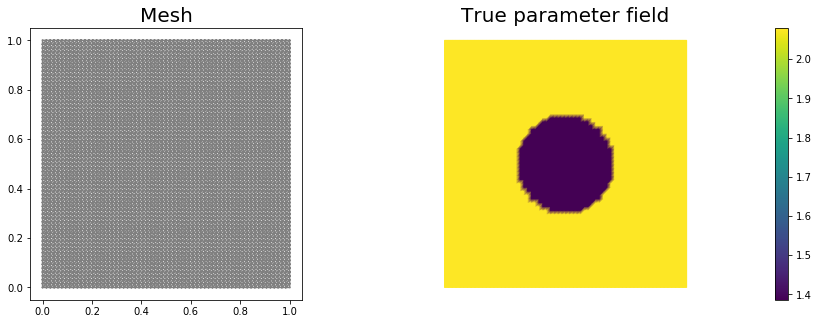
# Fix the value of the state at the center of the domain
def d_boundary(x,on_boundary):
return dl.near(x[0], .5) and dl.near(x[1], .5)
u0 = dl.Constant(0.)
bc_state = dl.DirichletBC(Vu, u0, d_boundary, "pointwise")
bc_adj = dl.DirichletBC(Vu, dl.Constant(0.), d_boundary, "pointwise")
3. Set up synthetic observations (inverse crime):
- Propose a coefficient field \(m_{\rm true}\) shown above
- The variational form of the PDE:
Find \(u\in \mathcal{V}\) such that
\(\underbrace{\int_\Omega e^{m_{\text true}} \nabla u \cdot \nabla v \, dx}_{\; := \; a_{\rm true}} - \underbrace{\int_{\partial\Omega} j\,v\,dx}_{\; := \;L_{\rm true}} = 0, \text{ for all } v\in \mathcal{V}\).
- Perturb the solution: \(u = u + \eta\), where \(\eta \sim \mathcal{N}(0, \sigma^2)\)
# noise level
noise_level = 0.05
# weak form for setting up the synthetic observations
a_true = dl.inner(dl.exp(mtrue) * dl.grad(u_trial), dl.grad(u_test)) * dl.dx
L_true = dl.inner(j, u_test) * dl.ds
# solve the forward/state problem to generate synthetic observations
A_true, b_true = dl.assemble_system(a_true, L_true, bc_state)
utrue = dl.Function(Vu)
dl.solve(A_true, utrue.vector(), b_true)
d = dl.Function(Vu)
d.assign(utrue)
# perturb state solution and create synthetic measurements d
# d = u + ||u||/SNR * random.normal
MAX = d.vector().norm("linf")
noise = dl.Vector()
A_true.init_vector(noise,1)
noise.set_local( noise_level * MAX * np.random.normal(0, 1, len(d.vector().get_local())) )
bc_adj.apply(noise)
d.vector().axpy(1., noise)
# plot
nb.multi1_plot([utrue, d], ["State solution with mtrue", "Synthetic observations"])
plt.show()
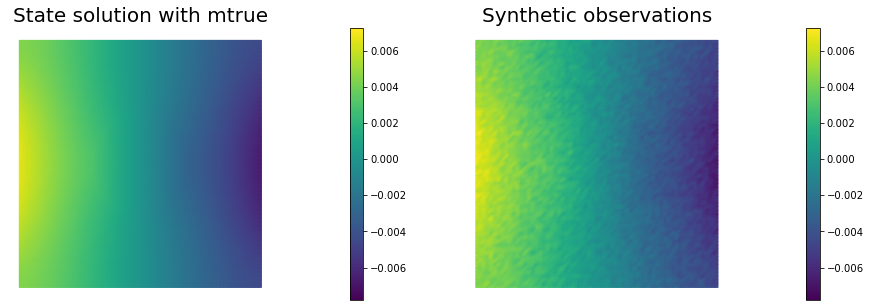
4. The cost function evaluation:
\[J(m):=\underbrace{\frac{1}{2}\int_\Omega (u-d)^2\, dx}_{\text{misfit} } + \underbrace{\frac{\gamma}{2}\int_\Omega|\nabla m|^2\,dx}_{\text{reg}}\]# regularization parameter
gamma = 1e-8
# define cost function
def cost(u, d, m,gamma):
reg = 0.5*gamma * dl.assemble( dl.inner(dl.grad(m), dl.grad(m))*dl.dx )
misfit = 0.5 * dl.assemble( (u-d)**2*dl.dx)
return [reg + misfit, misfit, reg]
5. Setting up the variational form for the state/adjoint equations and gradient evaluation
Below we define the variational forms that appears in the the state/adjoint equations and gradient evaluations.
Specifically,
a_state,L_statestand for the bilinear and linear form of the state equation, repectively;a_adj,L_adjstand for the bilinear and linear form of the adjoint equation, repectively;grad_misfit,grad_regstand for the contributions to the gradient coming from the PDE and the regularization, respectively.
We also build the mass matrix \(M\) that is used to discretize the \(L^2(\Omega)\) inner product.
# weak form for setting up the state equation
a_state = dl.inner(dl.exp(m) * dl.grad(u_trial), dl.grad(u_test)) * dl.dx
L_state = dl.inner(j, u_test) * dl.ds
# weak form for setting up the adjoint equation
a_adj = dl.inner(dl.exp(m) * dl.grad(p_trial), dl.grad(p_test)) * dl.dx
L_adj = -dl.inner(u - d, p_test) * dl.dx
# weak form for gradient
grad_misfit = dl.inner(dl.exp(m)*m_test*dl.grad(u), dl.grad(p)) * dl.dx
grad_reg = gamma*dl.inner(dl.grad(m), dl.grad(m_test))*dl.dx
# L^2 weighted inner product
M_varf = dl.inner(m_trial, m_test) * dl.dx
M = dl.assemble(M_varf)
6. Initial guess
We solve the state equation and compute the cost functional for the initial guess of the parameter m0
m0 = dl.interpolate(dl.Constant(np.log(4.) ), Vm )
m.assign(m0)
# solve state equation
state_A, state_b = dl.assemble_system (a_state, L_state, bc_state)
dl.solve (state_A, u.vector(), state_b)
# evaluate cost
[cost_old, misfit_old, reg_old] = cost(u, d, m, gamma)
# plot
plt.figure(figsize=(15,5))
nb.plot(m,subplot_loc=121, mytitle="m0", vmin=mtrue.vector().min(), vmax=mtrue.vector().max())
nb.plot(u,subplot_loc=122, mytitle="u(m0)")
plt.show()
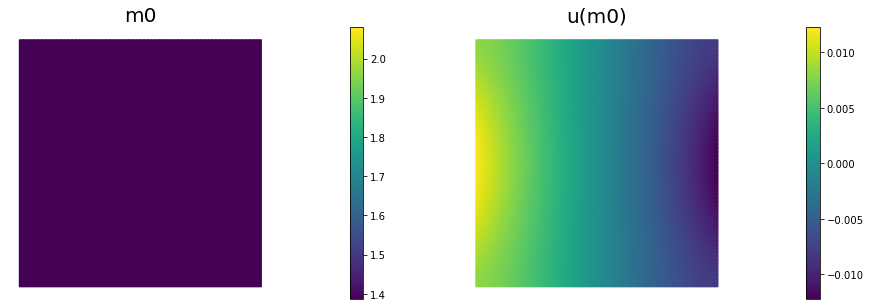
7. Variational forms for Hessian action
We define the following variational forms that are needed for the Hessian evaluation
-
W_varf,R_varfare the second variation of the data-misfit and regularization component of the cost functional respectively (note sinceW_varf,R_varfare independent of \(u\), \(m\), \(p\) they can be preassembled); -
C_varfis the second variation of the PDE with respect to \(p\) and \(m\); -
Wum_varfis the second variation of the PDE with respect to \(u\) and \(m\); -
Wmm_varfis the second variation of the PDE with respect to \(m\).
Note: Since the forward problem is linear, the bilinear forms for the incremental state and adjoint equations are the same as the bilinear forms for the state and adjoint equations, respectively.
W_varf = dl.inner(u_trial, u_test) * dl.dx
R_varf = dl.Constant(gamma) * dl.inner(dl.grad(m_trial), dl.grad(m_test)) * dl.dx
C_varf = dl.inner(dl.exp(m) * m_trial * dl.grad(u), dl.grad(u_test)) * dl.dx
Wum_varf = dl.inner(dl.exp(m) * m_trial * dl.grad(p_test), dl.grad(p)) * dl.dx
Wmm_varf = dl.inner(dl.exp(m) * m_trial * m_test * dl.grad(u), dl.grad(p)) * dl.dx
# Assemble constant matrices
W = dl.assemble(W_varf)
R = dl.assemble(R_varf)
8. Hessian action on a vector \(\bhm\):
Here we describe how to apply the Hessian operator to a vector \(\bhm\). For an opportune choice of the regularization, the Hessian operator evaluated in a neighborhood of the solution is positive define, whereas far from the solution the reduced Hessian may be indefinite. On the constrary, the Gauss-Newton approximation of the Hessian is always positive defined.
For this reason, it is beneficial to perform a few initial Gauss-Newton steps (5 in this particular example) to accelerate the convergence of the inexact Newton-CG algorithm.
The Hessian action reads: \(\begin{align} \bhu &= -\bA^{-1} \bC \bhm\, & \text{incremental forward}\\ \bhp &= -\bA^{-T} (\bW_{\scriptsize\mbox{uu}} \bhu + \bW_{\scriptsize\mbox{um}}\,\bhm) & \text{incremental adjoint}\\ \bH \bhm &= (\bR + \bW_{\scriptsize\mbox{mm}})\bhm + \bC^T \bhp + \bW_{\scriptsize\mbox{mu}} \bhu. \end{align}\)
The Gauss-Newton Hessian action is obtained by dropping the second derivatives operators \(\bW_{\scriptsize\mbox{um}}\,\bhm\), \(\bW_{\scriptsize\mbox{mm}}\bf \bhm\), and \(\bW_{\scriptsize\mbox{mu}} \bhu\): \(\begin{align} \bhu &= -\bA^{-1} \bC \bf \bhm\, & \text{incremental forward}\\ \bhp &= -\bA^{-T} \bW_{\scriptsize\mbox{uu}} \bhu & \text{incremental adjoint}\\ \bH_{\rm GN} \bhm &= \bR \bhm + \bC^T \bhp. \end{align}\)
# Class HessianOperator to perform Hessian apply to a vector
class HessianOperator():
cgiter = 0
def __init__(self, R, Wmm, C, A, adj_A, W, Wum, bc0, use_gaussnewton=False):
self.R = R
self.Wmm = Wmm
self.C = C
self.A = A
self.adj_A = adj_A
self.W = W
self.Wum = Wum
self.bc0 = bc0
self.use_gaussnewton = use_gaussnewton
# incremental state
self.du = dl.Vector()
self.A.init_vector(self.du,0)
#incremental adjoint
self.dp = dl.Vector()
self.adj_A.init_vector(self.dp,0)
# auxiliary vector
self.Wum_du = dl.Vector()
self.Wum.init_vector(self.Wum_du, 1)
def init_vector(self, v, dim):
self.R.init_vector(v,dim)
# Hessian performed on v, output as generic vector y
def mult(self, v, y):
self.cgiter += 1
y.zero()
if self.use_gaussnewton:
self.mult_GaussNewton(v,y)
else:
self.mult_Newton(v,y)
# define (Gauss-Newton) Hessian apply H * v
def mult_GaussNewton(self, v, y):
#incremental forward
rhs = -(self.C * v)
self.bc0.apply(rhs)
dl.solve (self.A, self.du, rhs)
#incremental adjoint
rhs = - (self.W * self.du)
self.bc0.apply(rhs)
dl.solve (self.adj_A, self.dp, rhs)
# Misfit term
self.C.transpmult(self.dp, y)
if self.R:
Rv = self.R*v
y.axpy(1, Rv)
# define (Newton) Hessian apply H * v
def mult_Newton(self, v, y):
#incremental forward
rhs = -(self.C * v)
self.bc0.apply(rhs)
dl.solve (self.A, self.du, rhs)
#incremental adjoint
rhs = -(self.W * self.du) - self.Wum * v
self.bc0.apply(rhs)
dl.solve (self.adj_A, self.dp, rhs)
#Misfit term
self.C.transpmult(self.dp, y)
self.Wum.transpmult(self.du, self.Wum_du)
y.axpy(1., self.Wum_du)
y.axpy(1., self.Wmm*v)
#Reg/Prior term
if self.R:
y.axpy(1., self.R*v)
9. The inexact Newton-CG optimization with Armijo line search:
We solve the constrained optimization problem using the inexact Newton-CG method with Armijo line search.
The stopping criterion is based on a relative reduction of the norm of the gradient (i.e. \(\frac{\|g_{n}\|}{\|g_{0}\|} \leq \tau\)).
First, we compute the gradient by solving the state and adjoint equation for the current parameter \(m\), and then substituing the current state \(u\), parameter \(m\) and adjoint \(p\) variables in the weak form expression of the gradient: \((\mathcal{G}(m), \tilde{m}) = \gamma\int_\Omega \nabla m \cdot \nabla \tilde{m} dx +\int_\Omega \tilde{m}\nabla u \cdot \nabla p\, dx.\)
Then, we compute the Newton direction \(\hat m\) by iteratively solving \(\mathcal{H} {\hat m} = -\mathcal{G}\). The Newton system is solved inexactly by early termination of conjugate gradient iterations via Eisenstat–Walker (to prevent oversolving) and Steihaug (to avoid negative curvature) criteria.
Usually, one uses the regularization matrix \(R\) as preconditioner for the Hessian system, however since \(R\) is singular (the constant vector is in the null space of \(R\)), here we use \(P = R + \frac{\gamma}{10} M\), where \(M\) is the mass matrix in parameter space.
Finally, the Armijo line search uses backtracking to find \(\alpha\) such that a sufficient reduction in the cost functional is achieved. More specifically, we use backtracking to find \(\alpha\) such that: \(J( m + \alpha \hat m ) \leq J(m) + \alpha c_{\rm armijo} (\hat m,g).\)
# define parameters for the optimization
tol = 1e-8
c = 1e-4
maxiter = 12
plot_on = False
# initialize iter counters
iter = 1
total_cg_iter = 0
converged = False
# initializations
g, m_delta = dl.Vector(), dl.Vector()
R.init_vector(m_delta,0)
R.init_vector(g,0)
m_prev = dl.Function(Vm)
print( "Nit CGit cost misfit reg sqrt(-G*D) ||grad|| alpha tolcg" )
while iter < maxiter and not converged:
# solve the adoint problem
adjoint_A, adjoint_RHS = dl.assemble_system(a_adj, L_adj, bc_adj)
dl.solve(adjoint_A, p.vector(), adjoint_RHS)
# evaluate the gradient
MG = dl.assemble(grad_misfit + grad_reg)
# calculate the L^2 norm of the gradient
dl.solve(M, g, MG)
grad2 = g.inner(MG)
gradnorm = np.sqrt(grad2)
# set the CG tolerance (use Eisenstat–Walker termination criterion)
if iter == 1:
gradnorm_ini = gradnorm
tolcg = min(0.5, np.sqrt(gradnorm/gradnorm_ini))
# assemble W_um and W_mm
C = dl.assemble(C_varf)
Wum = dl.assemble(Wum_varf)
Wmm = dl.assemble(Wmm_varf)
# define the Hessian apply operator (with preconditioner)
Hess_Apply = HessianOperator(R, Wmm, C, state_A, adjoint_A, W, Wum, bc_adj, use_gaussnewton=(iter<6) )
P = R + 0.1*gamma * M
Psolver = dl.PETScKrylovSolver("cg", amg_method())
Psolver.set_operator(P)
solver = CGSolverSteihaug()
solver.set_operator(Hess_Apply)
solver.set_preconditioner(Psolver)
solver.parameters["rel_tolerance"] = tolcg
solver.parameters["zero_initial_guess"] = True
solver.parameters["print_level"] = -1
# solve the Newton system H a_delta = - MG
solver.solve(m_delta, -MG)
total_cg_iter += Hess_Apply.cgiter
# linesearch
alpha = 1
descent = 0
no_backtrack = 0
m_prev.assign(m)
while descent == 0 and no_backtrack < 10:
m.vector().axpy(alpha, m_delta )
# solve the state/forward problem
state_A, state_b = dl.assemble_system(a_state, L_state, bc_state)
dl.solve(state_A, u.vector(), state_b)
# evaluate cost
[cost_new, misfit_new, reg_new] = cost(u, d, m, gamma)
# check if Armijo conditions are satisfied
if cost_new < cost_old + alpha * c * MG.inner(m_delta):
cost_old = cost_new
descent = 1
else:
no_backtrack += 1
alpha *= 0.5
m.assign(m_prev) # reset a
# calculate sqrt(-G * D)
graddir = np.sqrt(- MG.inner(m_delta) )
sp = ""
print( "%2d %2s %2d %3s %8.5e %1s %8.5e %1s %8.5e %1s %8.5e %1s %8.5e %1s %5.2f %1s %5.3e" % \
(iter, sp, Hess_Apply.cgiter, sp, cost_new, sp, misfit_new, sp, reg_new, sp, \
graddir, sp, gradnorm, sp, alpha, sp, tolcg) )
if plot_on:
nb.multi1_plot([m,u,p], ["m","u","p"], same_colorbar=False)
plt.show()
# check for convergence
if gradnorm < tol and iter > 1:
converged = True
print( "Newton's method converged in ",iter," iterations" )
print( "Total number of CG iterations: ", total_cg_iter )
iter += 1
if not converged:
print( "Newton's method did not converge in ", maxiter, " iterations" )
Nit CGit cost misfit reg sqrt(-G*D) ||grad|| alpha tolcg
1 1 1.73023e-07 1.73023e-07 4.15048e-14 2.61669e-03 1.72498e-05 1.00 5.000e-01
2 1 5.18873e-08 5.18873e-08 6.43554e-14 4.93109e-04 2.07678e-06 1.00 3.470e-01
3 1 5.14379e-08 5.14378e-08 6.01593e-14 2.99840e-05 2.13672e-07 1.00 1.113e-01
4 6 4.20315e-08 3.90111e-08 3.02040e-09 1.37758e-04 2.06854e-07 1.00 1.095e-01
5 7 4.19913e-08 3.89153e-08 3.07598e-09 8.96612e-06 1.66892e-08 1.00 3.110e-02
6 10 4.19901e-08 3.89161e-08 3.07398e-09 1.57459e-06 2.78638e-09 1.00 1.271e-02
Newton's method converged in 6 iterations
Total number of CG iterations: 26
nb.multi1_plot([mtrue, m], ["mtrue", "m"])
nb.multi1_plot([u,p], ["u","p"], same_colorbar=False)
plt.show()
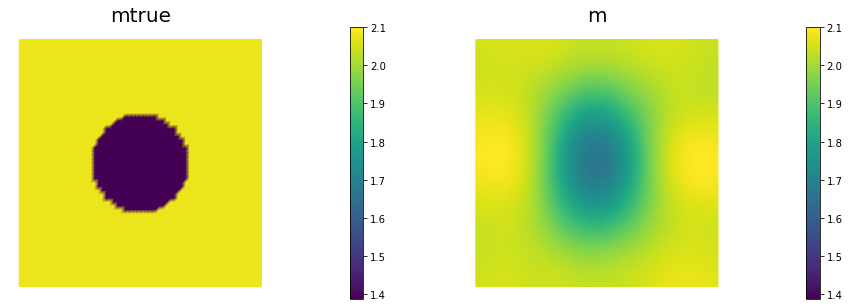
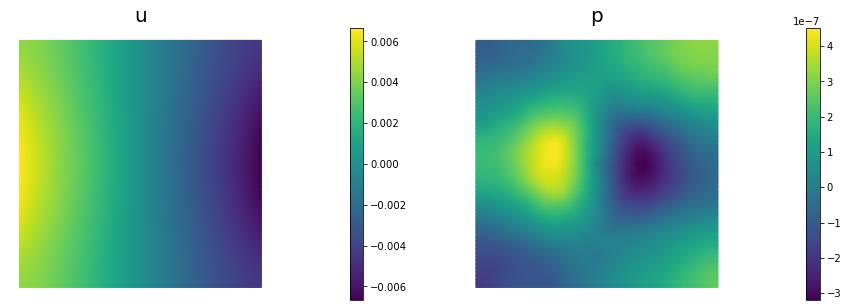
10. The generalized eigenvalues and eigenvectors of the Hessian misfit
We used the double pass randomized algorithm to compute the generalized eigenvalues and eigenvectors of the Hessian misfit. In particular, we solve
\[H_{\rm misfit} \hat{\bf m}_i = \lambda_i R \hat{\bf m}_i.\]The Figure shows the largest k generalized eigenvectors of the Hessian misfit. The effective rank of the Hessian misfit is the number of eigenvalues above the red line (\(y=1\)). The effective rank is independent of the mesh size.
Note: Since \(R\) is singular (the constant are in the null space of \(R\)), we will add a small mass matrix \(M\) to \(R\) and use \(P = R + \frac{\gamma}{10}M\) instead.
Hmisfit = HessianOperator(None, Wmm, C, state_A, adjoint_A, W, Wum, bc_adj, use_gaussnewton=False)
k = 50
p = 20
print( "Double Pass Algorithm. Requested eigenvectors: {0}; Oversampling {1}.".format(k,p) )
Omega = MultiVector(m.vector(), k+p)
parRandom.normal(1., Omega)
lmbda, evecs = doublePassG(Hmisfit, P, Psolver, Omega, k)
plt.plot(range(0,k), lmbda, 'b*', range(0,k+1), np.ones(k+1), '-r')
plt.yscale('log')
plt.xlabel('number')
plt.ylabel('eigenvalue')
nb.plot_eigenvectors(Vm, evecs, mytitle="Eigenvector", which=[0,1,2,5,10,15])
Double Pass Algorithm. Requested eigenvectors: 50; Oversampling 20.
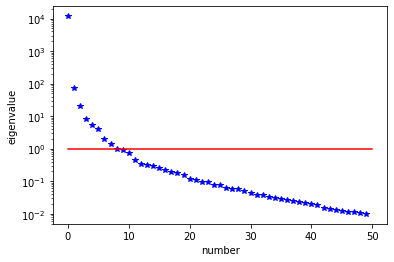
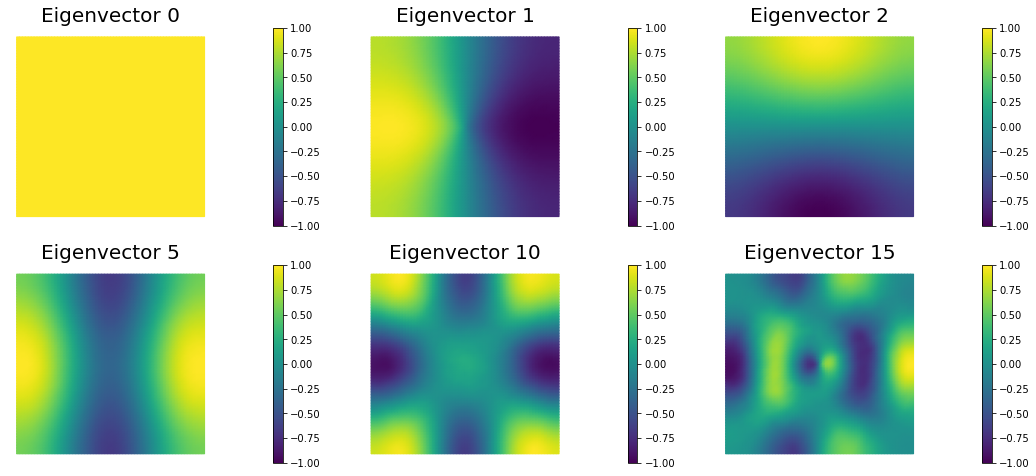
Copyright © 2019-2020, Washington University in St. Louis.
All Rights reserved. See file COPYRIGHT for details.
This file is part of cmis_labs, the teaching material for ESE 5932 Computational Methods for Imaging Science at Washington University in St. Louis. Please see https://uvilla.github.io/cmis_labs for more information and source code availability.
We would like to acknowledge the Extreme Science and Engineering Discovery Environment (XSEDE), which is supported by National Science Foundation grant number ACI-1548562, for providing cloud computing resources (Jetstream) for this course through allocation TG-SEE190001.
